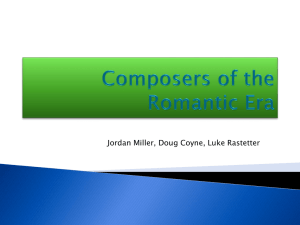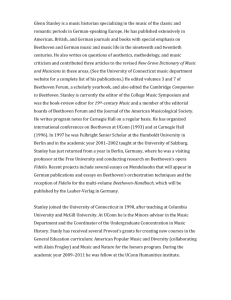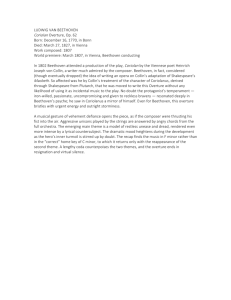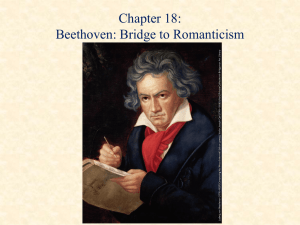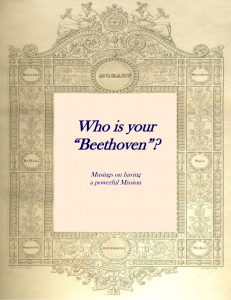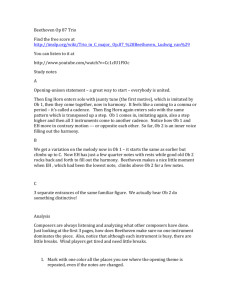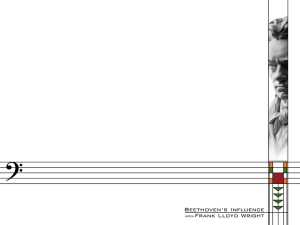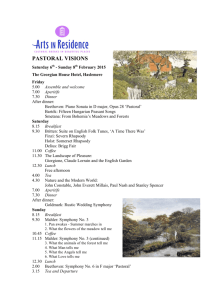Document
advertisement
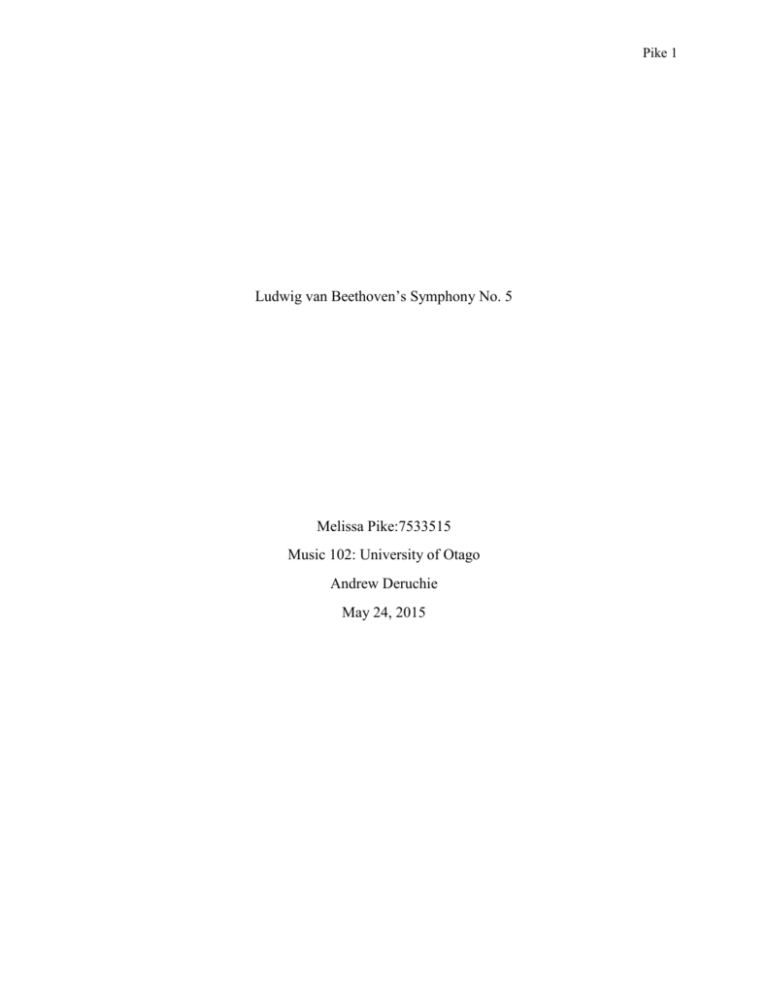
Pike 1 Ludwig van Beethoven’s Symphony No. 5 Melissa Pike:7533515 Music 102: University of Otago Andrew Deruchie May 24, 2015 Pike 2 Ludwig van Beethoven lived and worked within Europe from 1770 to 1827. The setting is post enlightenment era, where greats such as Mozart and Haydn had laid the foundation for a new music scene that a young Beethoven would work within1. Due to the time that Beethoven was working in, he was able to reach a larger audience, and bring about dramatic changes and unique qualities. During Beethoven’s life it is said that he had three major periods, this essay will examine two. The first being that he became well known in his youth as a child pianist and a composer working under figures such as Haydn. Because Beethoven himself was a pianist his early works included solo sonatas for keyboard. The sonata was a very important part of the classical era and came with its own unique form2. This included a standard first- movement which has three sections: an exposition, a development, and a recapitulation. A uniqueness to Beethoven’s piano pieces was his approach to texture, dynamic changes, and use of octaves. This continued into the second stage of Beethoven’s musical career and life. The second stage of Beethoven’s musical career was that of the utmost importance. This part of his life and career was when he was composing his symphonies. These symphonies were expressions of heroisms and drama. The setting for these symphonies was the city of Vienna. One major symphony to look at that exemplifies the style of the era and was performed in this iconic city was Ludwig van Beethoven’s Fifth Symphony in C Minor. The first movement of Beethoven’s Fifth Symphony is the best example to display the style and genre of the time period. The piece begins with a bold orchestral sound. One of which has an extreme power and drama about it. The power of this comes from the instruments utilized and the tempo. 3 Hf gkhdhf h 1 Wright, Craig and Bryan Simms. Music in Western Civilization. 571-573 2 Wright, Craig and Bryan Simms. Music in Western Civilization. 575 Beethoven, Ludwig von, “Serie 1: Symphonien, Nr. 5 Leipzig,” Ludwig van Beethovens Werke. Breitkopf & Hartel (1862). 3 3 Pike 3 The tempo marking of allegro con brio gives this piece a startup sound of brightness and boldness with a lively pace. Thus the stage is set for a dramatic performance. Also, the repetitive nature of the 4 beat phrase creates a strong and dramatic start as well. Beethoven has 6 different parts entering on the same beats to solidify what is to come next in the piece as well. The introduction of this is only just that, an introduction that will give way to the following material. This introduction though is also the presentation of the main theme for the movement. The exposition of this piece is a subsection of the first movement that is found in sonata form, which is what defines the genre of classical music. In the exposition the first theme is restated and expanded. 4 This section of the symphony displays the expansion of the original theme. Here there are many more instruments playing and the theme is getting worked with. It is moving towards something with a driving force. The notes that are being held during the fermata give the listener the sense that piece is heading somewhere even though it is in the tonic key of C minor. Next comes the second theme. The second theme of this piece is much lighter sounding even though there is still a pulsating tempo. An important thing to take note of in the second theme is how the piece modulates. This Beethoven, Ludwig von, “Serie 1: Symphonien, Nr. 5 Leipzig,” Ludwig van Beethovens Werke. Breitkopf & Hartel (1862). 4. 4 Pike 4 modulation from a minor key to the relative major is common of the time period and era in which Beethoven was composing his pieces5. In symphonies of the time period the next portion is known as the development. In the development music taken from the exposition continues to be worked with and manipulated. This is true in Beethoven’s Fifth symphony as well. In Beethoven’s fifth he starts out with a big band sound and then slowly removes instruments. By doing this it not only exemplifies the ability of individual players but it also allows for a conversation to be had across the orchestra. The little sections in the development give way for what seems like one or two ideas that slowly build up into a climax. This buildup relates to an idea of the era which is that of the human experience. Drama is a part of life and there is an unstable force, fate, which guides one to their destination6. From here the first movement follows the sonata form by returning to ideas from the exposition. The restatement of ideas from the exposition is recalled in the recapitulation. During the recapitulation in Beethoven’s fifth the first theme is repeated with its integrity intact but when the second theme comes back the entrance is different with the use of a bassoon. Lower strings then come in and build back up into a climax before a strong coda. It is this coda that makes the first movement of Beethoven’s fifth symphony so memorable and distinct. The boldness of the four note cadence that is repeated, manipulated, and contorted throughout the coda makes the ending of this piece heroic and stoic. 7 5 Wright, Craig and Bryan Simms. Music in Western Civilization. 579. Wright, Craig and Bryan Simms. Music in Western Civilization. 585. 7 Beethoven, Ludwig von, “Serie 1: Symphonien, Nr. 5 Leipzig,” Ludwig van Beethovens Werke. Breitkopf & Hartel (1862). 21. 6 Pike 5 The box above indicates the repeat of the cadence in the final portion of Beethoven’s Fifth Symphony that lead into a much dramatized 7 bar finale. It is through the use of cadence, key modulation, and drama that Beethoven’s music falls into the best of his era. His use of drama marks his style and allows for him to continue to be studies well into the future. The first movement of Beethoven’s Fifth Symphony serves as a perfect example of music form from the classical style. Pike 6 Bibliography Beethoven, Ludwig von, “Serie 1: Symphonien, Nr. 5 Leipzig,” Ludwig van Beethovens Werke. Breitkopf & Hartel (1862). Accessed May 24, 2015. http://imslp.nl/imglnks/usimg/0/0c/IMSLP52624-PMLP01586Beethoven_Werke_Breitkopf_Serie_1_No_5_Op_67.pdf Wright, Craig and Bryan Simms. Music in Western Civilization. Accessed May 24, 2015. https://blackboard.otago.ac.nz/bbcswebdav/pid-1251381-dt-content-rid9327797_1/courses/MUSI102_S1DNI_2015/Beethoven%20Readings.pdf.
